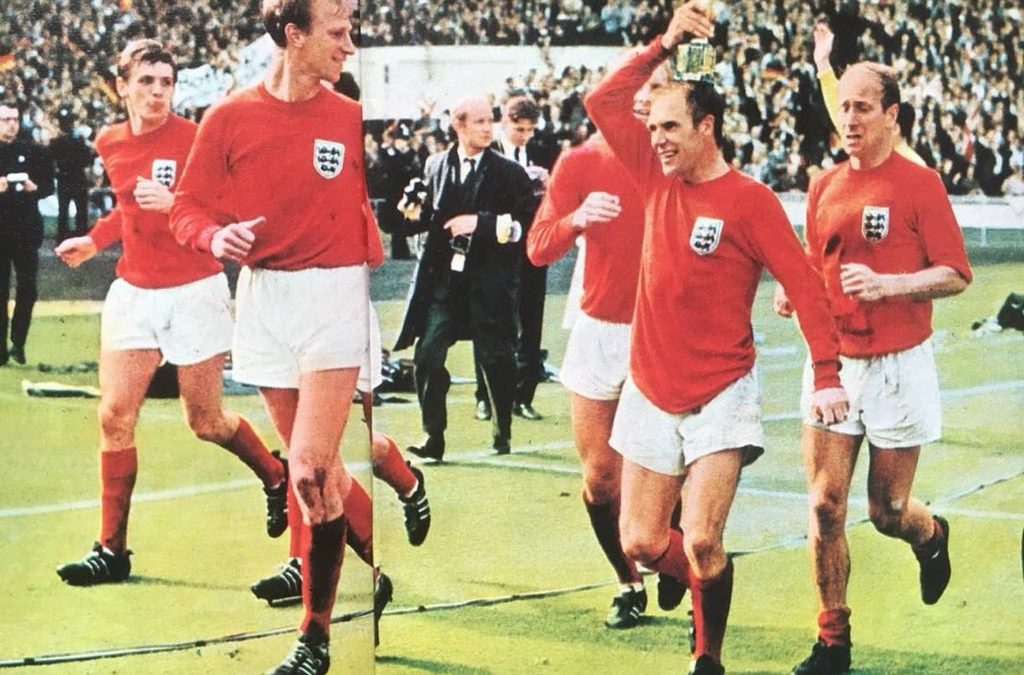THE RAY WILSON STORY
By Vince Cooper
WHILST Ray Wilson wasn’t one of the bigger characters in the 1966 World Cup winning team, and also wasn’t one of those who continued to be involved in the game after his playing career was over, his pace, tackling ability and efficiency were undoubtedly major factors in that side’s success.
At 31-years-old Wilson was the oldest member of the team on duty in the final and, along with Bobby Charlton and Bobby Moore, one of only three holdovers from the team which had played in the previous finals in Chile four years before and he brought experience to the side. He also bought an uncanny knack for suddenly appearing on a winger’s shoulder just as he was about to cross and whipping the ball away from him
Wilson retired from the game just five years after the big day at Wembley and spent the rest of his life running the funeral home he part-owned, barely making a ripple in the football world again until passing away in 2018 at the age of 83.
Ramon Wilson (the unusual first name comes from his mother’s adoration of Spanish film star Ramon Navarro) was born in Shirebrook, Derbyshire in 1934. His mother left the family home when he was three and returned three years later with a new husband to raise him.
Unhappy with life at home, 13-year-old Ray ran away and he was missing for six weeks before finally returning and settling down.
Ray (he soon shortened the name to avoid ridicule from schoolmates) first started out in football as an inside-left for his school before, because he was one of the smallest members of the team, he was switched to the left wing in order to, as he said; “Keep me away from the hard knocks that inside-forwards often have to take”.
When he started playing for Langworth Junction Boys’ Club he had moved back to inside-left with ‘the occasional game at left-half’.
Moving up to all-age football Wilson started playing for Langworth Junction Imps but it was a school teacher who brought him to the attention of Roy Goodall, trainer at Huddersfield Town. Invited to play for the Leeds Road club’s third team (at left half) he was shocked by the pace which was ‘three times anything I had ever been used to’. Despite this he impressed manager Andy Beattie enough that he was invited to join the groundstaff. There his jobs, like all apprentices, included clearing the terraces, tidying up the pitch and cleaning the boots of the first-teamers.
Wilson, who had left school with no qualifications, gave up his job as a railway fireman and moved to Yorkshire but, mostly playing on the left wing he struggled, making little progress and was seriously considering giving up the game.
Called up for National Service in a Field Regiment of the Royal Artillery, Wilson was posted to Egypt and disliked it so much that he later had a tattoo on his arm saying ‘Egypt Never Again’.
Now 20, he returned to Huddersfield although he was unsure whether the club actually wanted him. On his first day back he was asked to fill in at left-back during a midweek practice match . Manager Beattie was impressed and decided that the switch should become permanent although Wilson initially wasn’t happy with the move.
The player struggled at first with the positional change and he would later say that he; “Began to despair of ever making a success of the new role”. He would later admit that he again seriously considered quitting the game until sitting down with Beattie who instilled some self-belief and persuaded him to ‘give this full-back role a real try’.
With help from his manager and Goodall, both former international full-backs themselves along with reserve team manager Bill Shankly, Wilson gradually took to the new role and when still an amateur he was given his first-team debut in October 1955 at Old Trafford against champions-to-be Manchester United where his direct opponent was England international Johnny Berry.
Town lost Wilson’s first match 3-0 and struggled throughout the campaign before eventually suffering relegation. The full back made just a handful of starts that year and was still clearly learning his new position.
Wilson married Patricia Lumb in 1956 and in November Bill Shankly took over from Beattie as Huddersfield boss (in a typically bullish comment he would later call the player who he gave a full-time contract to ‘the best left-back in the business’) and although the club, hampered by financial restraints, found it hard to escape the second division, he was now comfortable in his position and quickly became a key member of the line-up.
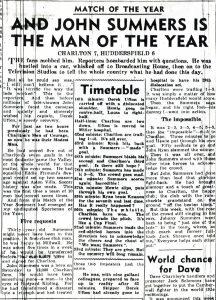
The ‘Match of the Year’
During this time he took part in one particularly memorable match. Huddersfield travelled to The Valley to meet Charlton Athletic and appeared to be coasting to victory when they held a 5-1 lead with just 25 minutes left. Then Charlton, led by winger Johnny Summers, who had decided at half time to try out a new pair of boots, came roaring back.
Summers ended up with five goals and Athletic won the match 7-6.
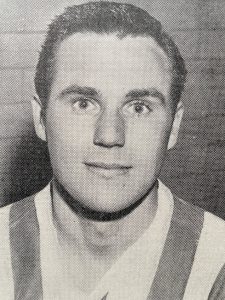
Denis Law also started out at Leeds Road and later said of his then-teammate whom he faced many times in training matches, and of course later on the international stage as well as when playing for the two Manchester clubs: “He is the most difficult defender to pass I have ever faced”.
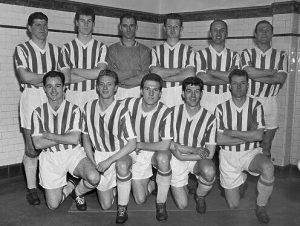
A Huddersfield line -up. Wilson far right in the back row. Denis Law Second from left in the front row.
Within a short period of time Wilson’s reputation had grown enough that second division status didn’t stand in his way when, in 1959, he received recognition and was called into the Football League team thar thrashed the Irish League 5-0 in Belfast with Brian Clough scoring all five.
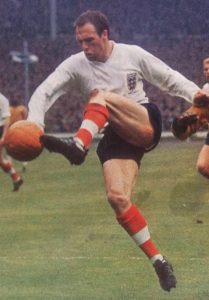
Early action for his country
In April 1960 Wilson made his full international debut and it came in front of 129,183 fans at Hampden Park as England drew 1-1 with Scotland (and Law) in the Home International Championship. It wasn’t a completely happy debut for the defender as in the second minute of the match he clashed with Scottish forward Graham Leggat (who he would later describe as one of the best he played against) and suffered a broken nose.
A mistake by Bill Slater allowed Leggat to give Scotland the lead but England got a share of the spoils when Bobby Charlton was fouled in the box and got up to send Frank Haffey the wrong way from the penalty spot. England could have gone on to win as they were awarded a second penalty towards the end but Charlton shot straight at Haffey and then, after a retake was ordered, blasted it over the bar.
England had three matches at the end of the 1959-60 season and Wilson kept his place for all three. But after a draw with Yugoslavia and defeats in Spain and Hungary he found himself out of favour with Middlesbrough’s Mick McNeill enjoying an extended run in the position. He regained the number three shirt for the 1-1 draw with Wales in Cardiff in October 1961 and thereafter made the place his own.
At club level he was in demand. Ex-boss Shankly had moved on to Liverpool and was keen to take him to Anfield whilst Manchester City, Spurs and Chelsea were among others reportedly interested in prising him away from Leeds Road but he remained there until 1964.
One of the major attributes in Wilson’s game was his pace, an asset he knew was important. “A full-back must develop his speed”, he once said; “it is a mistake to think that because you are a defender you are in a static position and do not need to move quickly.
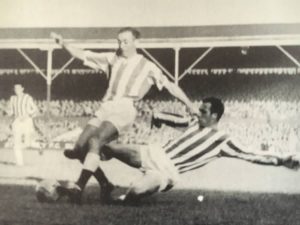
Up against Stanley Matthews
“If anything the perfect full-back should be quicker off the mark than the winger he covers”.
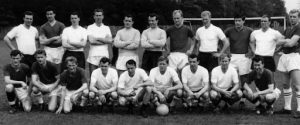
The 1962 World Cup squad with Ray one from far right standing. Far right is Bobby Moore.
Whilst the pace would serve Wilson well against the majority of wingers it did little to help him in the 1962 World Cup quarter-final. He had played well as the team secured their last eight place but then came up against perhaps the best right-winger in the world at the time in Brazil’s Garrincha.
The ‘Little Bird’ had an outstanding match and scored twice, but both goals came when he moved off the wing to look for room after finding little of it out wide. He scored with a rare header and then with a 25-yarder from the centre of the pitch as well as making the other goal for Vavá.

Tackling Garrincha
Wilson kept his place and played in 16 unbeaten matches, missing out on the 5-2 European Championship defeat to France through injury. Included in that run was an appearance in the English F.A’s centenary match win over the Rest of the World at Wembley.
The unbeaten run came to an end and it was again at the hands of Brazil. This time it was Pele who ran the show in a 5-1 hammering in the ‘Little World Cup’ in Rio.
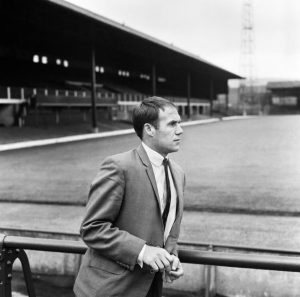
A last look at Leeds Road
On his return from Brazil, Wilson got the move that had seemed likely for so long. It was Everton boss Harry Catterick who finally managed to meet Huddersfield’s terms and he moved across the Pennines with a cheque for £40,000 going in the other direction. He had won 30 caps while at Leeds Road, a club record.

Ray packs his boots
He missed a handful of internationals when replaced by the versatile Bobby Thomson of Wolves as Alf Ramsey experimented but when he started to settle on his team for 1966 Wilson was back in the line up.
His first match back didn’t exactly go according to plan when he was forced to leave the pitch with a rib injury just before half time in the April 1965 2-2 draw with Scotland at Wembley. But he was back in the line up the following month as Jimmy Greaves’ goal gave the team a 1-0 win over Hungary.
In December 1965 Ramsey employed the ‘wingless wonders’ formation for the first time in the 2-0 win over Spain in the Bernabeu Stadium. The tactical change gave greater responsibility to full-backs Wilson and George Cohen to provide the width going forward.
As the 1965-66 season started to reach its peak Wilson was battling for success on the club front with Everton marching towards Wembley and the FA Cup final.
For their first warm up match of 1966 England played against Poland at Wilson’s home ground, Goodison Park. A rare Bobby Moore goal earned the home team, playing without the injured Bobby Charlton, a share of the spoils.
The next match saw West Germany visit Wembley and Wilson was a substitute with Keith Newton making his England debut.
Newton was injured late in the first half and Wilson replaced him at half time. Geoff Hurst also won his first cap but it was another unlikely figure, this time Nobby Stiles, who popped up with the only goal of the game.
Wilson’s first taste of 1966 Wembley glory came when Everton came from behind to beat Sheffield Wednesday 3-2 in an exciting FA Cup final.
The Goodison Park team had reached Wembley without conceding a goal and were hot favourites so it came as something of a surprise when Wednesday took a 2-0 lead. But the Toffees came storming back with goals from Mike Trebilcock (2) and Derek Temple giving them the trophy.
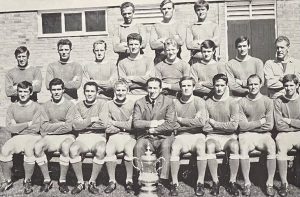
Everton. FA Cup winners 1966
Then, of course, came the World Cup. Wilson played every minute of every match. His never seemed under pressure at left back and skipper Bobby Moore later paid tribute to him, saying; “Ray closed off opposition attacks before they could develop and covered me on the left flank before I knew I might need it”. That cover was crucial.
For all of his many attributes Moore would have been the first to admit that he wasn’t the quickest. But when needed Wilson was perfectly positioned to cover for his skipper.
Throughout the tournament Ramsey had tinkered with his forward line before eventually settling on his line up in the quarter-final against Argentina. But the back six stayed the same. “We were a defensive team”, Ray would recall years later. “That was the first quality of the team”.

Ray with fellow squad member Jimmy Greaves
In the final itself Wilson made a rare mistake when, in the 13th minute he ‘most untypically’ weakly headed a cross out. The ball was pounced on by Helmut Haller for West Germany’s opener.
It was indeed a rare slip and from then on he had an excellent game. Wilson’s previous national team full-back partner Jimmy Armfield later said of him; “Ray had pace and superb positional sense, but also greater ball skills than the majority appreciated. He seldom wasted a ball”.
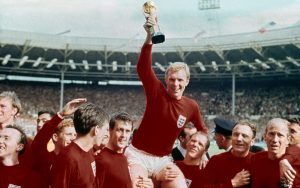
Ray lifts Bobby
He also had the honour of being the ‘fourth man’ featured in the famous photo (and on the statue) with the three West Ham players as Bobby Moore was on his shoulders holding the Jules Rimet trophy after the final whistle.
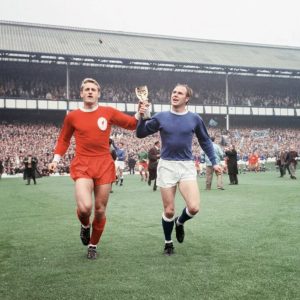
Parading the trophy at Goodison with England teammate Roger Hunt
Already 31 and the oldest member of the team, Wilson stayed in the line-up for two more years and was in the team which beat the USSR to claim 3rd place at the 1968 European championships. That game provided won him his 63rd and final cap as he was replaced briefly by Bob McNab and then by Terry Cooper.
The 1967-68 season also featured Wilson’s last appearance on the big stage for Everton as he took part in the club’s extra-time FA Cup final defeat at the hands of West Bromwich Albion.
In 1969 he was given a free transfer by the Toffees moving first to Oldham Athletic and then on to Bradford City where he also had a brief spell as manager.
He then left the professional game completely in 1971, although he played in Sunday amateur football while taking a job in his father-in-law’s successful funeral business (‘he turned out to be an excellent funeral director’ said father-in-law Ed Lumb). In later years he became a regular at Huddersfield Town matches, supporting the team alongside his sons.
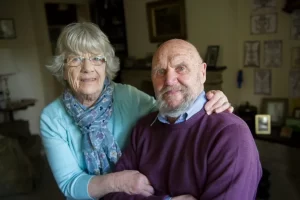
Ray with wife Patricia
In 2004 Wilson was diagnosed with Alzheimer’s Disease and he lived quietly at home, being cared for by Patricia, his wife of 63 years and still often attending games at Leeds Road before his condition deteriorated and he passed away in a care home in 2018 at the age of 83.
Undoubtedly one of the unsung heroes of the World Cup-winning team, Ray Wilson was nonetheless integral to their success and his pace and positional sense and exemplary defending played a key role for his country for nine years, including their greatest day.

